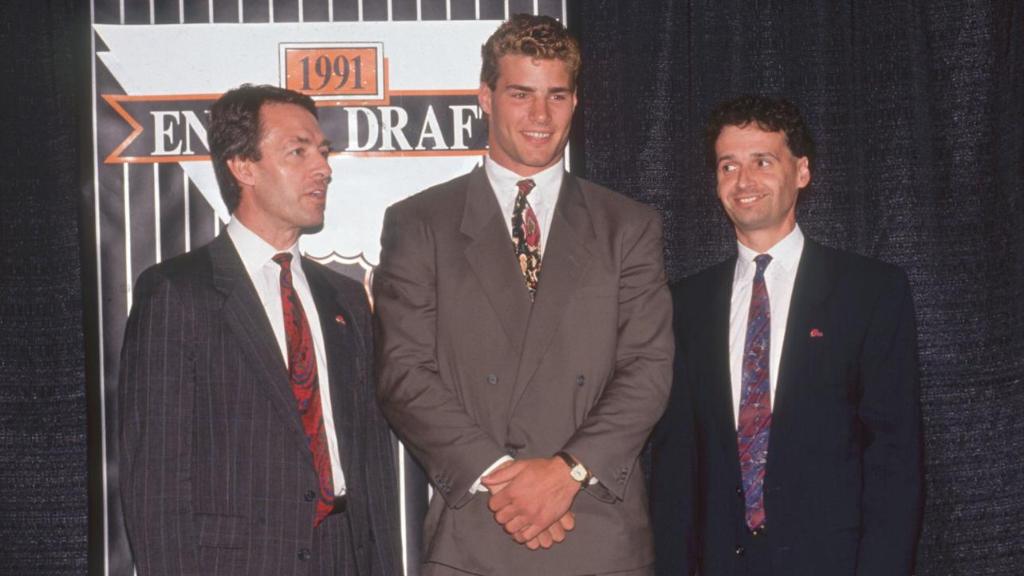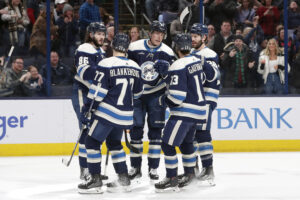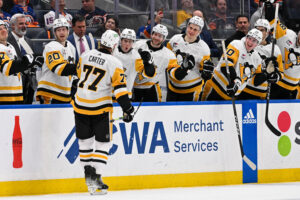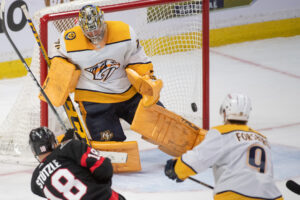The NHL Draft is just under a few weeks away. The draft always provides plenty of drama and intrigue amongst fans and media. This has been true since its inception. While people tend to get excited about trades and prospects, there are other moments that leave people scratching their heads. For this edition, we head back to 1991 when the top prospect in the draft gave the team picking first overall an ultimatum and how it lay the groundwork for two teams Stanley Cup triumphs.
The Eric Lindros Power Play
The Next One
Eric Lindros was an elite-level prospect playing for the OHL’s Oshawa Generals. He had the rarest of skillsets. An incredible goal scorer who could skate and could also physically dominate the opposition. Lindros played parts of three seasons in Oshawa (1990-92) scoring 180 goals, 200 assists, 380 points, and 437 penalty minutes in 157 games. He led the Generals to the OHL and Memorial Cup championships in 1990. In 1991 he won the OHL scoring title as well as the league’s MVP and was named the top player in the CHL. He represented Canada at the 1990 and 1991 IIHF World Junior Hockey Championships, winning gold in both years. In the summer of 1991, he played for the senior national team at the Canada Cup, winning gold as well.
NHL scouts were salivating over the anointed ‘Next One’. As were the Quebec Nordiques who held the number one pick in the 1991 NHL Draft. The Nordiques saw Lindros as the centrepiece of their franchise turnaround. While the Nords were locked in on Lindros, he was not so locked in on Quebec.
The Power Play
Leading up to the draft, Lindros made it clear to the Nordiques that he would not sign with them if he was selected. The reasoning behind the decision was a bit fuzzy. Publicly the Lindros camp insisted it had to do with the ownership in Quebec. There were also stories that Lindros wanted to play in an English market to maximize his endorsement potential. This wasn’t the first time Lindros refused to play for a team. When being drafted into the OHL, the Sault St. Marie Greyhounds selected Lindros first overall but Lindros refused to sign. He was eventually traded to the Generals. One thing is for sure, the Lindros camp was no stranger to making these types of power plays to get what they wanted.
Heading into the 1991 NHL Draft, there was tons of anticipation about what was going to happen.
1991 NHL Draft
Despite the warnings from the Lindros camp, the Nordiques selected Lindros first overall. He went up on the stage but refused to put on the Nordiques jersey and hat. Quebec believed that once both parties began negotiating a deal would get worked out. The Nordiques also felt (as other small-market teams must have as well) that if players could decide not to go where they are drafted it would mean the end of their franchise.
THIS DAY IN NHL HISTORY: The Nordiques draft Eric Lindros at No. 1. https://t.co/TwPqTuqVac #NHLDraft pic.twitter.com/2wgW9hDXgH
— NHL (@NHL) June 22, 2016
The Nordiques at that time were a mess. This was the third consecutive year they had the number one overall pick, selecting Owen Nolan and Mats Sundin in the previous two drafts. They also had Joe Sakic and Adam Foote emerging and Soviet stars Valeri Kamensky and Alexei Gusarov joining the team. So despite their poor play over the last three seasons, there was some optimism for the team’s future.
At the negotiating table, Lindros demanded a $3 million dollar per year salary in hopes of scaring off the Nords. When it didn’t, Lindros refused to sign and returned to Oshawa for the 1991-92 season.
Not Alone
Lindros is not the only player to use their status as an elite prospect to determine their fate. Famously, in 1984 Mario Lemieux refused to put on the Pittsburgh Penguins jersey or shake hands with the Penguins general manager at the draft. Although that had more to do with a contract dispute than refusing to play somewhere. A good comparison to this is John Elway in the NFL. He was drafted by the (then) Baltimore Colts first overall despite warning the team he would not play for them. In the end, Elway would be moved to the Denver Broncos but it caused a lot of drama at the 1983 NFL draft.
1992 NHL Draft
For the 1991-92 season, Lindros played with the Oshawa Generals and the Canadian National Team at the 1992 Olympics. For a year, Lindros and the Nordiques played a game of high-stakes chicken. All the way up to the 1992 NHL Draft. There was a sense of great anticipation at the draft. Nobody knew what was going to happen, but it seemed something was about to happen. Was Lindros going to sign or would Quebec trade him?
Embed from Getty Images
After the year-long stalemate, the Nordiques ended up blinking first. Believing that even if they held firm, signing Lindros would just lead to resentment on both sides. So they began to take offers for the prized prospect. The Nordiques fielded offers from the Toronto Maple Leafs, Calgary Flames, Chicago Blackhawks, New Jersey Devils, Philadelphia Flyers, New York Rangers, and Detroit Red Wings. It seemed a bidding war was coming.
The Offers
Detroit was initially considered a front-runner with a deal that included Steve Yzerman. The Red Wings captain, however, balked at the idea of playing in Quebec and said he would refuse to play. So Detroit was out. The Flames (apparently) had an offer that included Mike Vernon and two of the following (for Quebec to choose) Theoren Fleury, Al MacInnis, Gary Roberts, Gary Suter, or Joe Nieuwendyk. Toronto was offering three or four quality players, draft picks and cash. Chicago was offering four or five quality players cash and draft picks. There were even rumours the Montreal Canadiens had an offer that included Patrick Roy. Teams were serious about landing the ‘Big E’.
When all the dust settled it came down to two teams, the Rangers and Flyers. Both teams put forward their best offers and the Nordiques had to make a choice… or did they? As if this story need more drama, there was now a question as to which team would actually acquire Lindros.
The Trade(s)
The trade offer from the Flyers was ’91 first-round pick Peter Forsberg, Ron Hextall, Mike Ricci, Steve Duchesne, two first-round picks (more on that later) and $15 million dollars. The Rangers offer was Tony Amonte, Alexei Kovalev, Sergei Nemchinov, James Patrick, one of Mike Richter or John Vanbiesbrouck, several (it’s not known exactly how many) first-round picks and $20 million.
Those are two heavyweight offers for Lindros. In the end, the Nordiques agreed to both. They initially made a verbal agreement with the Flyers for the trade, but then Nordiques President Marcel Aubut felt the Rangers’ offer was better and then agreed with them. Since nothing was official with the league, it seemed the Rangers would get Lindros. The Flyers claimed Quebec reneged on their deal and filed a complaint about the matter with the NHL. The debate over who owned the rights to Lindros continued.
To settle the matter, NHL President Gil Stein appointed Toronto lawyer Larry Bertuzzi to settle the dispute through arbitration. After a five-day hearing, Bertuzzi ruled the Flyers deal was enforceable. Due to the debate over which trade would be upheld, there needed to be an amendment to the Flyers trade. Initially, the Flyers’ 1992 first-round pick was part of the deal, however since the draft was over at this point, Quebec had the choice to take the player drafted or another pick. The Nordiques chose to take the future draft pick. The Flyers also agreed to send Chris Simon as part of the deal as well.
The Fallout
So how did the trade play out for each of the teams involved? It worked out pretty good for all parties but some more than others.
Flyers/Lindros
Lindros made his NHL debut for the Flyers in the 1993-94 season. He came as advertised. Lindros scored 41 goals and 75 points in his rookie campaign. He followed that up with a 44-goal 97-point season as a sophomore. In the lockout-shortened 1994-95 season, Lindros finished tied for the lead league in points with 70 in 46 games (but closed the Art Ross due to a tie-breaker) and won the Hart Trophy as the NHL MVP. While the Flyers seemed to always be on the verge of being true contenders, they could never get over the hump.
Falling Out of Favor
As for Lindros, he also was always on the cusp of being the dominant force he was expected to be but injuries, specifically concussions seriously derailed his career. It also led to the deterioration of Lindros’ relationship with the Flyers. The relationship with the Flyers ended in 2001 when he was traded to… the New York Rangers. After two seasons in New York, he signed as a free agent with the Maple Leafs. Unfortunately, the injury bug hit again Lindros retired from the NHL following the 2007 season.
Still, in his career, Lindros scored 372 goals and 865 points in 760 games. He might be one of the biggest “what if’s” in NHL history. Unfortunately, his injuries really deprived him and the NHL of what he could have been. Even with his limited career, Lindros was inducted into the Hall of Fame in 2016.
Quebec/Colorado
After the trade, the Nordiques had a great year. They won 47 games and put up 104 points. It looked like the worm had turned for the struggling franchise. In 1994-95 the centrepiece of the trade, Peter Forsberg joined the team and proceeded to win the Calder Trophy as rookie of the year. The Nordiques won their division but suffered a first-round upset in the playoffs. It would be the last season for the Nordiques. The team was sold and moved to Colorado.
Embed from Getty Images
The Colorado Avalanche would go on to win the Stanley Cup in their first season in Denver. Forsberg was a key contributor, scoring 116 points in the regular season and 21 points in the playoffs. The Avs would be a constant Stanley Cup contender from 1996 to 2003, winning a second Cup in 2001. The trade with the Flyers directly led to the Avs acquiring the following players, Patrick Roy, Uwe Krupp, Ray Bourque, Rob Blake, Claude Lemieux, Paul Stastny, Alex Tanguay, and Theoren Fleury among others. The Avalanche were still seeing a return on this trade in 2007.
Any way you slice it, the Lindros trade worked out amazing for the Quebec/Colorado franchise… not so great for the fans left behind in Quebec City though.
Rangers
The Rangers were fortunate their trade was not approved. The players that they would have given up all played a role in the Rangers Stanley Cup victory in 1994 and beyond. Mike Richter was a great goalie and Alex Kovalev was stellar in the ’94 playoffs. Richter posted a 2.07 GAA, a .921 save percentage and four shutouts. Kovalev had nine goals and 21 points. Tony Amonte and James Patrick were involved in trades that brought Brian Noonan, Steve Larmer and Stephane Matteau to the big apple. All three were vital to the Rangers Cup win as well. Despite missing out on a generational talent, the Rangers were somewhat lucky their offer was rejected.






